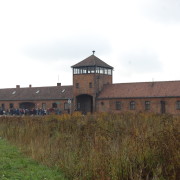Auschwitz: Graveyard or Media Platform
By Leah Killian
When visiting places like Auschwitz-Birkenau it is important to remember where you are. Not only are these places historically important sites and museum, but they are also graveyards to the millions of people who died there. This important fact is not something that is easily forgotten unless you have a phone or camera in front of your face the entire time. The way that memory is treated at Auschwitz-Birkenau is very respectful for the most part, however there are many tourist and visitors who come to Auschwitz and do not respect what happened on the very ground they stand nor the people who were murdered there.
Auschwitz-Birkenau and other sites like it face the unique challenge of being both a place which to inform the public about the atrocities that happened during World War II, by using first hand learning, but also being the sites of mass graves or the last location of someone before they died. This struggle is something that Auschwitz, as a memorial and museum, has been dealing with for years. The problem has become much more acute with advancing technology. With the use of sites like Instagram and Facebook people, especially young people, are always connected. They can share pictures and experiences with the world, but should they? The inappropriate use of these sites when it comes places like Auschwitz-Birkenau are very troubling to me, since I would never think of disrespecting these places in such a way.
One of the first things I saw when I walked up to the entrance off Auschwitz-Birkenau was a bunch of tourists in a group tour, much like the one I was in. However, where the group I was with was listening to our guide and viewing the camp with our eyes, the other group was not. They were viewing the camp through their phones, taking selfies in front of the entry gate that reads “Arbeit Macht Frei” and taking pictures of the camp from every angle. It was shocking to say the least. This place was supposed to be a museum and a memorial for what happened there and yet people treated it like it was the White House or the Statue of Liberty. What I observed only got worse throughout the day. When we arrived at Birkenau I saw the same sort of behavior. People posing along the railway tracks; boyfriends trying to get the perfect picture of their girlfriends with the gate of the camp in the background; selfies taken in every part of the camp. When I got back to the hotel for the night I had an idea to look at the location of Auschwitz-Birkenau on Instagram, I wish I hadn’t done that.
A majority of the photos were respectful and commemorated the past of the spot that they were taken, however there were far too many pictures that did not do that. Mixed in with general picture of the camp were posed pictures of people smiling while standing on the train tracks that delivered people to their deaths; pictures of people smiling with their babies like this place was just a random park they had come across, people showing the world their “ootd” (outfit of the day), and using throwback Thursday to post pictures of their “adventures” in Poland. Yet the worst were the selfies. Going through the different tags, I discovered there were over 20 before the next batch of pictures even loaded. For people to think that taking selfies in a place such as Auschwitz is okay astounds me. To discover so many posted pictures, on top of those I witnessed being taken, was deeply disturbing. Facebook, at first glance, appeared to be much better. This might be because it is not just a picture-sharing platform, but also one for news and videos that are education. Yet when I started to look at public pictures, I once again came across a plethora of selfies and posed photos.
This is not to say that people should not take pictures to commemorate these places, but people must be respectful and act accordingly when they are at places like Auschwitz-Birkenau. We must remember that this is not just a memorial site and museum but also the resting place for thousands of souls, a place that should be respected and ground that should be hallowed just like any other burial site. Taking pictures is an important part of documenting history, but to disrespect a place such as Auschwitz by posing for an Instagram picture that has nothing to do with what happened there, or taking 10 selfies of yourself all over camp because you want the world to know that you were there, is not historical. People must learn that there is a time and place to do such things and just because we can do something does not mean that we should.








